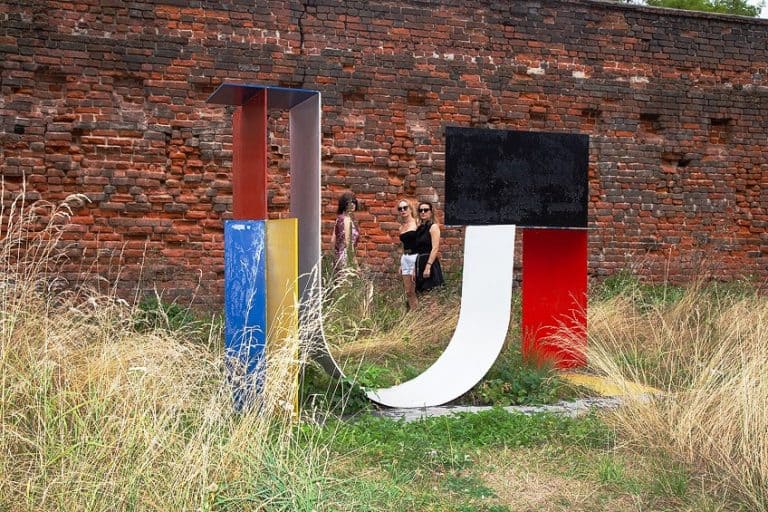Friedensreich Hundertwasser – Discover the Austrian Visual Artist
Friedensreich Hundertwasser, the prolific Austrian visual artist, left a remarkable impact on the world of art and architecture with his distinctive and vibrant creations. Known for his groundbreaking works in both Hundertwasser paintings and Hundertwasser architecture, this visionary artist’s unique blend of aesthetics, ecological consciousness, and philosophical depth has captivated audiences worldwide. In this article, we delve into the life and artistic legacy of Friedensreich Hundertwasser, exploring the colorful tapestry of his career, the profound impact of his paintings, and the innovative architectural designs that continue to inspire creatives around the world.
The Inventive Austrian Visual Artist: Who Was Friedensreich Hundertwasser?
| Date of Birth | 15 December 1928 |
| Date of Death | 19 February 2000 |
| Place of Birth | Vienna, Austria |
| Art Movements | Transautomatism, Surrealism, Expressionism, and the Vienna School of Fantastic Realism |
| Genre/Style | Modern art |
| Mediums Used | Watercolor, oil paint, egg tempera, lacquers, and crushed earth |
| Dominant Themes | The unity of humans and nature, individualism, cityscapes, and architecture |
Friedensreich Hundertwasser, originally named Friedrich Stowasser, was born on December 15, 1928, in Vienna, Austria, and went on to become one of the most influential and unconventional artists of the 20th century. His life and career were marked by a deep affinity to nature, a passionate advocacy for environmental sustainability, and a profound commitment to individual expression in art and architecture.

Early Life and Education: A Shaping of Identity and Vision
Friedensreich Hundertwasser’s early life was characterized by a confluence of personal challenges, historical upheaval, and a growing passion for art that would come to define his entire existence. Born on December 15, 1928, in Vienna, Austria, Hundertwasser was the son of Elsa Stowasser, a Jewish woman, and Ernst Stowasser, a civil engineer.
His familial background bestowed upon him a diverse cultural heritage, one that would deeply influence his artistic and philosophical outlook later in life.
World War Two and Persecution
The tumultuous period of World War Two cast a long shadow over Hundertwasser’s formative years. As a result of his Jewish ancestry, his family faced persecution during the war, a perilous time when countless lives were upended and extinguished by the Holocaust. To escape the horrors of deportation and persecution, Hundertwasser assumed a false identity, a perilous act of survival that would indelibly shape his worldview. These traumatic experiences instilled in him a profound awareness of human suffering and the need for empathy, values that would later find expression in his art and philosophy.

Post-War Pursuit of Art
After the war, Hundertwasser’s passion for art blossomed, driving him to pursue formal artistic training. In 1948, he enrolled at the Academy of Fine Arts in Vienna, an institution that had nurtured the talents of renowned artists such as Gustav Klimt (1862-1918) and Egon Schiele (1890-1918).
This period marked the genesis of Hundertwasser’s artistic journey and the development of his distinctive style.
Development of a Unique Artistic Voice
It was during his time at the Academy that Hundertwasser began to forge his own artistic identity. Rejecting the constraints of conventional art, he embarked on a path that embraced organic, irregular forms and a vibrant, emotionally charged palette. The rejection of straight lines, a signature aspect of his work, was not just an artistic choice but a philosophical statement, an assertion of the need to break free from the rigid norms that had contributed to the turmoil of the preceding decades.

Hundertwasser’s experiences during World War Two and his artistic training converged to form the bedrock of his artistic and philosophical perspectives. His art would come to embody a unique blend of personal identity, a celebration of individualism, a reverence for the natural world, and a commitment to advocating for human rights and environmental sustainability. These early life experiences were not just chapters in his biography but the very fabric from which his art and ideals were woven, ultimately shaping the legacy of Friedensreich Hundertwasser as a visionary artist and thinker.
Name Change
In 1949, Hundertwasser legally changed his name from Friedrich Stowasser to Friedensreich Hundertwasser, a name he felt was symbolic of his commitment to peace and freedom. “Friedensreich” means “realm of peace.”
This change marked his desire to create art that embodied harmony and spiritual connection with the natural world.
Artistic Style
Hundertwasser’s art is characterized by its vibrant, almost psychedelic colors, irregular shapes, and a denial of straight lines. He believed that straight lines were “godless” and instead championed the use of spirals, curves, and organic forms in his work. His paintings often featured intricate patterns, bold contrasts, and meticulous attention to detail, creating a sense of rhythm and energy that was uniquely his own.

Hundertwasser Paintings
Hundertwasser’s paintings covered a wide range of subjects, but nature, architecture, and the human condition were recurring themes. His works often depicted fantastical landscapes and buildings, which seemed to defy the laws of physics and geometry.
He used art as a means to express his reverence for the natural world and his concern for its preservation.
Hundertwasser Architecture
In addition to his paintings, Hundertwasser was a pioneering architect. He believed that architecture should be in harmony with nature and should prioritize the well-being of its inhabitants. His architectural designs were groundbreaking, featuring irregular, tree-covered facades, undulating floors, and organic shapes. One of his most famous architectural creations is the Hundertwasserhaus in Vienna, a colorful and whimsical apartment complex that exemplifies his philosophy of “architecture with a human face.”

Environmental Activism
Hundertwasser was not only an artist and architect but also a passionate environmentalist. He advocated for the preservation of natural resources, the reduction of pollution, and the integration of green spaces into urban environments. His “Tree Tenants” manifesto called for the planting of trees on rooftops and balconies.
This is a concept that has gained traction in modern sustainable architecture.
Legacy
Friedensreich Hundertwasser’s legacy is felt not only through his art and architecture but also through his profound impact on environmental consciousness in the creative fields. His visionary approach to design and his unwavering commitment to a harmonious coexistence with nature continue to inspire artists, architects, and environmentalists around the world.

Hundertwasser’s life was a testament to the power of art to convey deep-seated beliefs and provoke meaningful change. His innovative, eco-conscious designs and his colorful, exuberant paintings remain a testament to his enduring influence on the world of art and architecture. Friedensreich Hundertwasser passed away on February 19, 2000, but his spirit and artistic vision continue to resonate with generations of admirers and continue to shape the way we perceive and interact with the world around us.
Artistic Innovation and Socio-Political Impact
Friedensreich Hundertwasser’s imaginative creations emerged on the international art scene during a time of profound socio-political change and artistic evolution. This section of the article explores the socio-political impacts and art history context that shaped Hundertwasser’s art, emphasizing his unique approach to both art and architecture and his passionate commitment to environmental and societal causes.

Art History Context
Hundertwasser’s artistic journey began in the aftermath of World War II, a period marked by upheaval and the questioning of established norms. In the immediate post-war years, the art world was still recovering from the impact of two devastating world wars. Abstract Expressionism, Cubism, and Surrealism paved the way for artists to explore new frontiers of creativity, liberated from traditional artistic constraints.
It was in this atmosphere of experimentation that Hundertwasser found his artistic voice.
Socio-Political Influences
Hundertwasser’s art was not created in a vacuum; it was deeply influenced by his socio-political beliefs. Having witnessed the horrors of war and the devastating impact of totalitarianism, he became a fervent advocate for human rights, peace, and individual freedom.
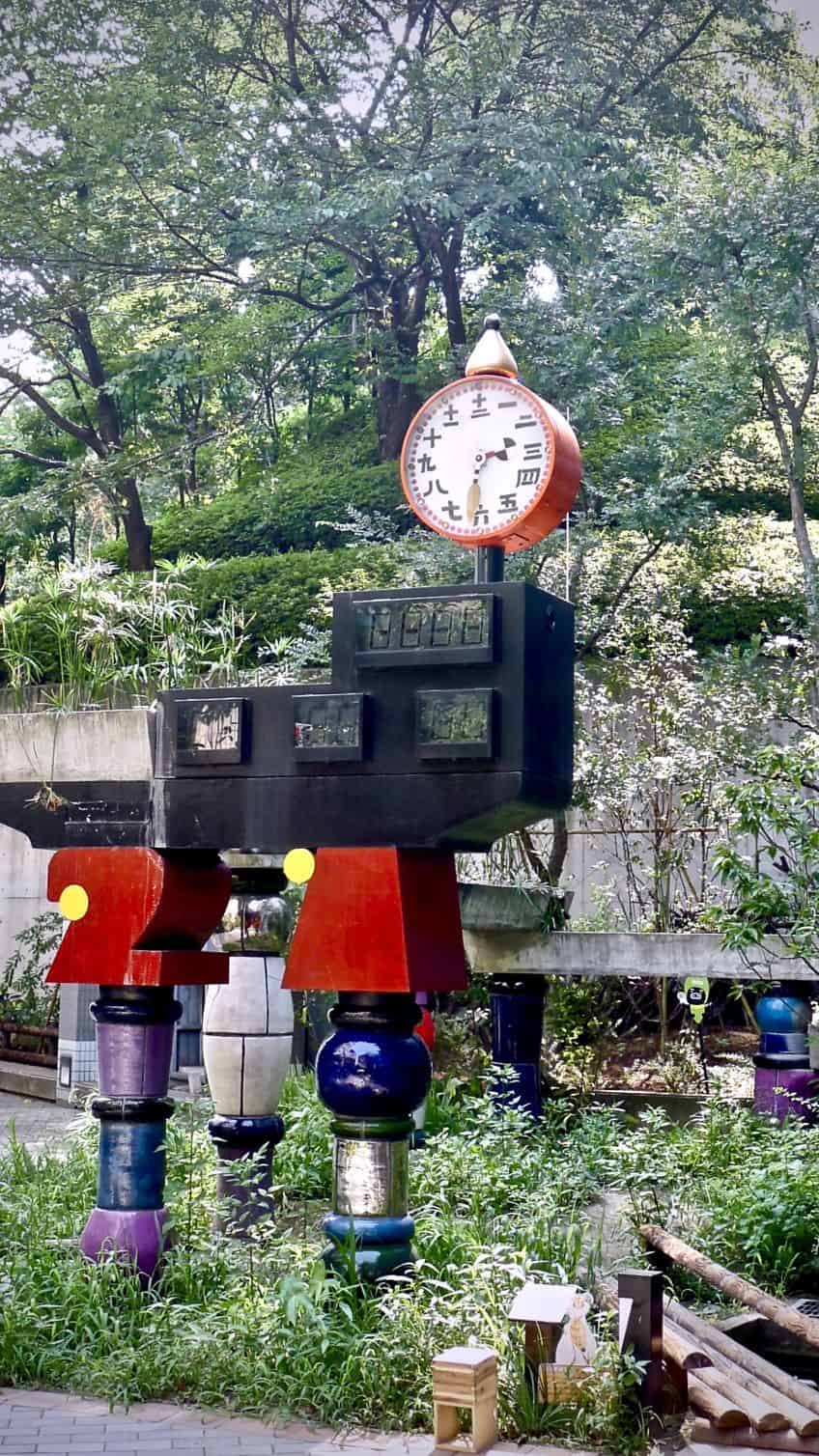
Rejecting Convention
Hundertwasser’s art was a defiant departure from convention. He abandoned geometric precision favored by many contemporary artists, famously declaring them “godless.” Instead, he embraced uneven shapes, curls, and organic forms that resonated with the rhythm of nature. His vibrant, almost psychedelic use of color and intricate patterns was a direct response to the austerity of post-war Europe.
Hundertwasser’s works, whether paintings or architectural designs, exuded a sense of joyful liberation and a celebration of individualism.
Environmental Consciousness in Hundertwasser’s Work: A Vision of Harmony with Nature
Friedensreich Hundertwasser’s artistic and philosophical journey was not confined to the realm of aesthetics or socio-political advocacy alone. It extended to a profound environmental awareness that would shape his work and leave an enduring impact on the fields of architecture and art. As the 1960s and 1970s ushered in the environmental movement, Hundertwasser’s voice emerged as a passionate advocate for wildlife, weaving the theme of ecological sustainability into the fabric of his artistic vision.
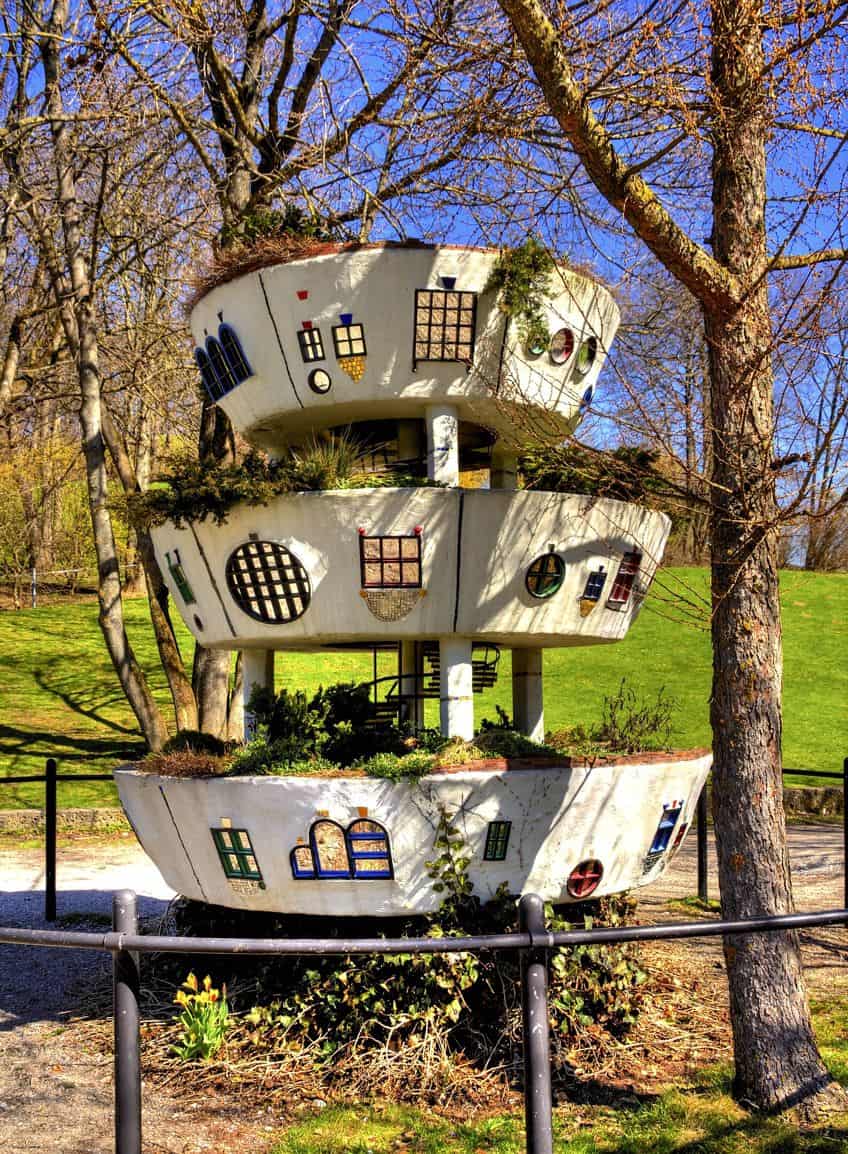
A Growing Concern for Nature
Hundertwasser’s environmental consciousness was a natural extension of his deep-rooted connection with the natural world. Having witnessed the destructive consequences of industrialization and urbanization during his lifetime, he became increasingly alarmed by the degradation of nature and the disconnection between humans and their environment.
This concern found its way into his art and architectural designs, where he sought to bridge the gap between the built environment and the natural world.
Hundertwasser Architecture
One of the most tangible expressions of Hundertwasser’s socio-political and environmental convictions was his architectural work. His buildings, characterized by their irregular shapes, colorful facades, and incorporation of vegetation, were a direct response to what he saw as the dehumanizing and nature-alienating aspects of modern urban planning.

The “Tree Tenants” Manifesto
One of the most prominent expressions of Hundertwasser’s environmental philosophy was his “Tree Tenants” manifesto, which he first articulated in 1953. This visionary manifesto called for the integration of green spaces into urban architecture, envisioning buildings adorned with trees, shrubs, and vegetation.
Hundertwasser argued that such integration was essential for the well-being of urban dwellers, as it would enhance air quality, provide insulation, and foster a sense of harmony with nature.
Friedensreich Hundertwasser’s Global Impact: A Catalyst for Change
Friedensreich Hundertwasser’s influence transcended borders and disciplines, leaving an unforgettable mark on artists, architects, and art movements worldwide. His unique blend of artistic invention, socio-political responsiveness, and environmental advocacy resonated deeply with a generation seeking alternative perspectives and creative expressions.

Architects and Architecture
Hundertwasser’s rejection of the sterile, uniform aesthetics of modern architecture in favor of a more biological, humanistic approach has influenced architects around the world. Renowned architects such as Frank Gehry (1929-Present), who designed the Guggenheim Museum in Bilbao, Spain, and Santiago Calatrava (1951-Present), known for his organic and sculptural designs, have acknowledged Hundertwasser’s impact on their work.
Hundertwasser’s emphasis on individualism and his vision of “architecture with a human face” challenged the notion that buildings should prioritize productivity over human well-being, leading to a reevaluation of architectural norms.
Green Architecture and Sustainability
Hundertwasser’s advocacy for the integration of nature into urban architecture, as seen in his “Tree Tenants” concept, laid the foundation for the green architecture movement. Contemporary architects and urban planners now prioritize the inclusion of green spaces, such as rooftop gardens and vertical gardens, in their designs to enhance sustainability and improve the quality of urban living. Hundertwasser’s ideas about sustainable architecture, energy efficiency, and the importance of ecological harmony continue to guide environmentally conscious architects and urban designers.

Environmental Art and Land Art
Hundertwasser’s commitment to environmental sustainability and his integration of nature into his architectural designs had a profound impact on the environmental art and land art movements. Artists like Christo (1935-2020) and Jeanne-Claude (1935-2009), known for their large-scale environmental installations, drew inspiration from Hundertwasser’s fusion of art and nature.
His vision of creating a harmonious coexistence between human-made structures and the natural world has been a guiding principle for environmental artists seeking to raise awareness about ecological issues through art.
Artists and Art Movements
Hundertwasser’s celebration of individualism and self-expression in art found resonance with artists exploring similar themes. His rejection of conformity and embrace of inconsistent forms inspired a generation of artists to break free from established artistic norms. The 1960s and 1970s, marked by countercultural movements, saw artists embracing a more personal, intuitive, and organic approach to their work, often rejecting the rigidity of mainstream art.
Hundertwasser Architecture: A Symphony of Color, Nature, and Humanism
Hundertwasser Architecture, the brainchild of Austrian artist and architect Friedensreich Hundertwasser, stands as a testament to the fusion of art and architecture in pursuit of a more balanced, ecologically mindful, and human-centric built environment. Characterized by its rich facades, quirky shapes, incorporation of nature, and rejection of the conventional grid, Hundertwasser’s architectural designs represent a revolutionary departure from the sterile and uniform urban landscapes of the 20th century.

A Rebel Against the Linear
Central to Hundertwasser’s architectural philosophy was his nonacceptance of the straight line. He believed that they disconnected architecture from the biological patterns of nature. This philosophy was grounded in the idea that humans actually feel more at home and at peace in structures that resemble nature – that way reinforcing the concept that humans are, in fact, a part of nature just like all other beings and organisms on this planet. In his architectural designs, one finds a profusion of curves, circles, and bizarre shapes, imparting a sense of life, movement, and vitality to the built environment.
This radical departure from architectural norms challenged the status quo and invited viewers to embrace the beauty of imperfection.
Kuchlbauer Tower: An Architectural Masterpiece by Friedensreich Hundertwasser
The Kuchlbauer Tower, located in Abensberg, Germany, stands as a testament to the creative genius of Austrian artist and architect Friedensreich Hundertwasser. Completed in 2010, this remarkable building is a true architectural masterpiece, celebrated for its unique design and philosophical underpinnings that blend art, architecture, and environmental consciousness. Key features that make the Kuchlbauer Tower special are:
- Sculptural and whimsical form: The most striking feature of the Kuchlbauer Tower is its sculptural and whimsical form. Rising 35 meters (115 feet) into the sky, the tower’s design is characterized by its irregular, onion-like domes, reminiscent of Hundertwasser’s rejection of straight lines and geometric uniformity. The playful, almost fairy-tale quality of the structure immediately captures the viewer’s imagination.
- Mosaic exterior: Like many of Hundertwasser’s architectural creations, the Kuchlbauer Tower features a facade adorned with colorful mosaics. These intricate, handcrafted patterns are a hallmark of his work, adding texture, depth, and visual interest to the building’s exterior. Each mosaic tile is unique, reflecting his commitment to celebrating individualism and self-expression.
- Environmental sustainability: Hundertwasser’s commitment to environmental sustainability is manifest in the Kuchlbauer Tower. The building incorporates various eco-friendly features, including rainwater harvesting, natural ventilation, and energy-efficient design principles. It serves as a model for environmentally conscious architecture, aligning with Hundertwasser’s belief in the importance of ecological harmony.
- Visitor experience: Beyond its architectural significance, the Kuchlbauer Tower offers visitors a unique experience. Inside, the tower houses a museum dedicated to beer, as it was commissioned by the Kuchlbauer Brewery. Visitors can explore the brewing process, Hundertwasser’s philosophy, and the history of beer production, making it an educational and immersive destination.

A Human-Centric Approach
Hundertwasser’s architectural designs were fundamentally human-centric. He sought to create spaces that nurtured the individual’s spirit and encouraged self-expression. His buildings featured irregularly shaped windows that allowed residents to choose their own views, rather than imposing a standardized perspective.
The Technical Marvels of Hundertwasser’s Art: A Journey into Vibrancy and Complexity
Friedensreich Hundertwasser’s art, renowned for its resonant colors, complex patterns, and distinctive shapes, is not only a visual feast but also a technical marvel that challenges conventional artistic standards. This section of the article delves into the technical characteristics that define Hundertwasser’s paintings.
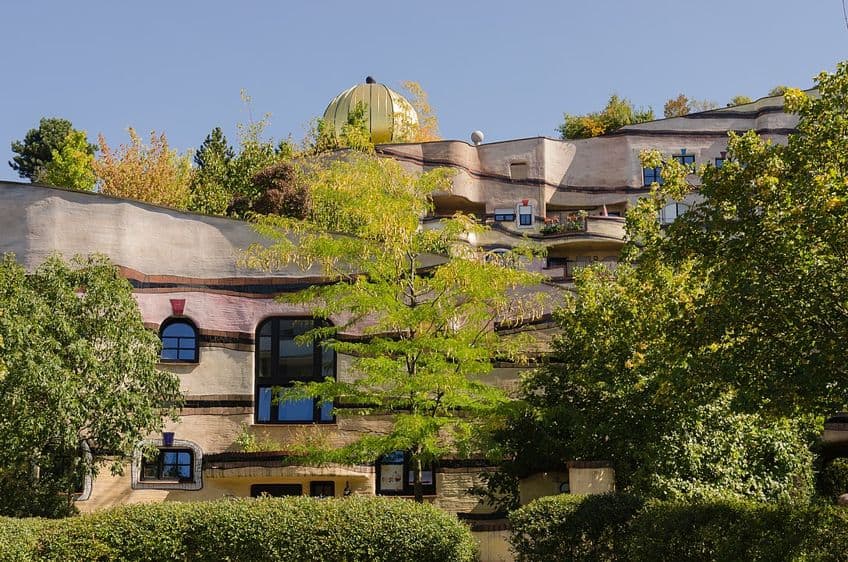
Color as a Primary Tool
Hundertwasser’s use of color is one of the defining features of his art. He once said, “Color is a means of exerting direct influence on the soul.” His choice of colors was meticulous and deliberate, with each hue carefully selected to evoke emotion and convey meaning. His palette often included bold primary colors juxtaposed with intricate, detailed patterns, creating a visual language that resonated with viewers on an emotional level.
The vibrancy of his colors and their unexpected combinations served to jolt the viewer out of complacency and into a world of heightened sensory experience.
Rejection of Straight Lines
A hallmark of Hundertwasser’s art is his vehement rejection of straight lines and geometric precision. He considered straight lines to be devoid of life and spirituality and instead championed the use of arcs, spirals, and fluid shapes. This technical choice was not merely an artistic preference but a philosophical statement, reflecting his belief in the harmony of nature and the need for art to embrace the imperfections and irregularities of life. This rejection of straight lines required a high degree of technical skill to execute, as the artist had to create complex compositions without relying on traditional geometric guides.

Pattern Complexity
Hundertwasser’s art is characterized by intricate, highly detailed patterns that often appear almost hypnotic in their complexity. These patterns were meticulously hand-drawn, a time-consuming and labor-intensive process that required great precision and patience. The intricate patterns served multiple purposes in his art, from creating a sense of rhythm and movement to symbolizing the interconnectedness of all things.
The technical challenge of consistently and precisely executing these patterns was a testament to Hundertwasser’s dedication to his craft.
Mixed Media Mastery
Hundertwasser was not confined to a single medium; he seamlessly blended various techniques and materials in his art. His mixed-media approach often included watercolors, ink, acrylics, and even collage elements. The combination of these materials added depth and texture to his works, contributing to their overall complexity and visual richness. This mastery of mixed media required a deep understanding of the characteristics and interactions of each material, highlighting Hundertwasser’s technical versatility.

Attention to Detail
One of the most remarkable technical aspects of Hundertwasser’s art is his obsessive attention to detail. Whether in his paintings, prints, or architectural designs, every element was considered and crafted with precision. His dedication to detail extended to the frames he designed for his paintings, each one unique and complementary to the artwork it encased.
This meticulous attention to detail elevated his art to a level of sophistication that demanded close examination and rewarded viewers with hidden intricacies.
Hundertwasserhaus (1985): A Masterpiece of Architectural Expression
| Title | Hundertwasserhaus |
| Opened | 1985 |
| Architects | Friedensreich Hundertwasser and Joseph Krawina |
| Function | Apartment |
| Architectural Style | Expressionist architecture |
| Location | Vienna, Austria |
The Hundertwasserhaus, located in Vienna, Austria, is a prime example of the architectural vision and creativity of Friedensreich Hundertwasser. Completed in 1985, this iconic building is a striking departure from conventional architecture, featuring a riot of colors, strange shapes, and an integration of nature that challenges established norms and invites viewers into a world of whimsy and harmony.

Architectural Features
Let us explore the architectural features of this space:
- Odd shapes: The most immediate and striking characteristic of the Hundertwasserhaus is its rejection of straight lines and geometric precision. Instead, the building’s facade is composed of undulating floors, irregularly shaped windows, and asymmetrical balconies. This absence of regularity adds a sense of vitality and movement to the structure, making it appear as if it is in a constant state of flux.
- Colorful facades: The Hundertwasserhaus is a symphony of vibrant colors. Each apartment has its own unique color scheme, with no two alike. Hundertwasser believed that individuals should be able to express their personalities through their living spaces, and this diversity of colors reflects his commitment to individualism and self-expression.
- Integration of nature: One of the most defining features of the Hundertwasserhaus is its incorporation of nature into the design. The rooftop of the building is covered with trees and vegetation, a concept that Hundertwasser referred to as “Tree Tenants.” This not only provides improved insulation and air quality but also establishes a harmonious connection between the building and the natural environment.
- Mosaics and ceramic columns: The building’s facade is adorned with mosaics and ceramic columns, handcrafted by Hundertwasser himself. These intricate details add a level of texture and visual complexity to the exterior, drawing the eye and inviting viewers to explore the building’s surfaces.
Philosophical Underpinnings
The Hundertwasserhaus is more than just a building, it is a symbol of architectural rebellion and a celebration of individuality and nature. Its influence can be seen in contemporary sustainable and green architecture, where the integration of nature and a focus on the well-being of occupants have become central principles.
Let us look at some of the philosophical underpinnings.
- Humanism: The Hundertwasserhaus is a testament to Hundertwasser’s humanistic approach to architecture. He believed that architecture should prioritize the well-being and individuality of its occupants. The irregular shapes and unique colors of each apartment reflect his commitment to providing residents with a sense of ownership and self-expression within their living spaces.
- Rejection of uniformity: In a world of standardized and monotonous architecture, Hundertwasser’s rejection of uniformity was a radical statement. He saw the uniformity of modern architecture as dehumanizing and believed that it disconnected people from their environments. His irregular, colorful designs were a direct challenge to this conformity.
The Third Skin (1982)
| Title | The Third Skin |
| Date | 1982 |
| Medium | Mixed media |
| Dimensions (cm) | 56,5 x 73 |
| Location | KunstHausWien, Vienna, Austria |
The Third Skin is one of Friedensreich Hundertwasser’s iconic paintings, a vibrant and intricate masterpiece that reflects his unique artistic vision and philosophy. In this analysis, we will delve into the visual and conceptual elements that define this remarkable work of art. The Third Skin is characterized by a bold and vibrant color palette. Deep blues and greens dominate the composition, while bursts of fiery reds and oranges punctuate the canvas. These colors are not only visually striking but also emotionally charged, evoking a sense of vitality, passion, and intensity.
Hundertwasser’s rejection of refined lines is evident in the weird shapes that populate the painting. Curves, spirals, and organic forms dominate, creating a sense of fluidity and movement. These irregular shapes contribute to the overall sense of dynamism in the artwork.
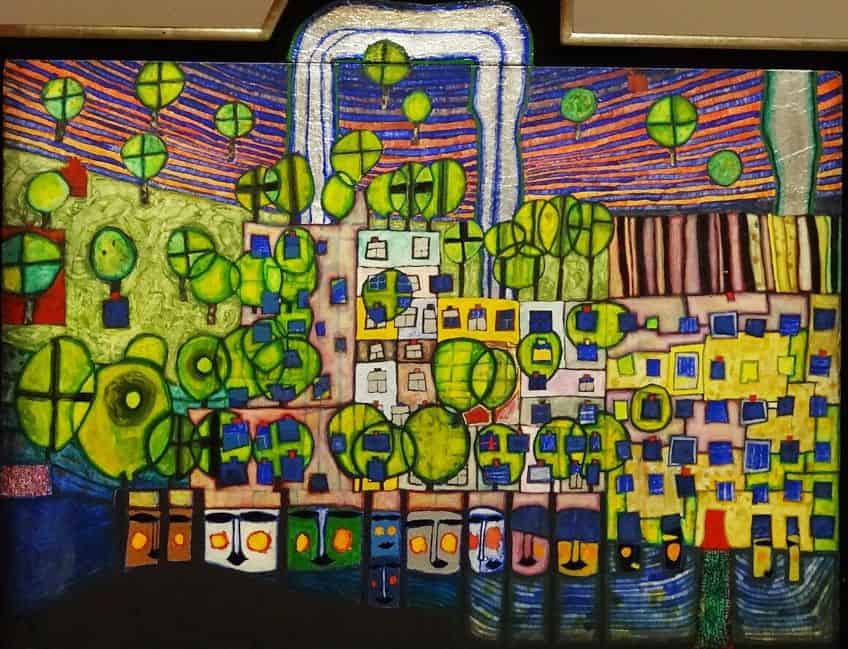
The painting is adorned with intricate patterns and details that demand close inspection. These patterns are meticulously hand-drawn, revealing Hundertwasser’s meticulous attention to detail and his dedication to craftsmanship. The patterns create a sense of rhythm and complexity, drawing the viewer deeper into the artwork. The Third Skin strikes a delicate balance between symmetry and asymmetry. While there is a sense of balance and harmony in the composition, it is not rigidly symmetrical. This asymmetry adds an element of surprise and unpredictability to the painting, inviting viewers to explore its nuances.
Hundertwasser’s deep connection with nature is a recurring theme in his work, and it is evident in The Third Skin. The organic shapes and the rich, earthy colors suggest a profound reverence for the natural world. The painting invites viewers to consider their relationship with the environment and the need for a harmonious coexistence with nature.
The rejection of straight lines and the celebration of irregular shapes in the painting are symbolic of Hundertwasser’s commitment to individualism and self-expression.
The Third Skin encourages viewers to embrace their own uniqueness and to resist conformity. There is a spiritual dimension to Hundertwasser’s art, and it is palpable in this painting. The swirling, almost hypnotic patterns and the fiery bursts of color evoke a sense of transcendence and inner exploration. It is as if the painting invites viewers to delve into the depths of their own consciousness. The bold colors and dynamic forms in The Third Skin convey a powerful sense of emotion and energy. There is a palpable intensity to the artwork, as if it is pulsating with life and passion. This emotional resonance is a hallmark of Hundertwasser’s art.
Transautomatism and The Third Skin
Even though The Third Skin is sometimes classified as a Transautomatism painting, Friedensreich Hundertwasser was not typically classified as a Transautomatism artist. While Hundertwasser incorporated elements of spontaneity, irregularity, and intuitive expression into his work, he did not primarily align with the Transautomatism movement or label.
Hundertwasser’s artistic style was more closely associated with Surrealism, Expressionism, and the Vienna School of Fantastic Realism. His rejection of straight lines and geometric precision, his use of vibrant colors, and his incorporation of organic, irregular forms reflected his unique artistic vision. He often emphasized the importance of individualism and a closer connection between humans and nature in his work and architectural designs.

Transautomatism, on the other hand, typically involves a blending of automatism (where subconscious or random elements dominate) with conscious or deliberate artistic choices. While Hundertwasser’s work had elements of spontaneity and an organic feel, it was not primarily driven by the automatist techniques that are central to Transautomatism.
In conclusion, Friedensreich Hundertwasser, the renowned Austrian visual artist, left a memorable mark on the world of art and architecture through his distinctive and visionary contributions. Hundertwasser’s paintings and architectural designs are vibrant testaments to his rejection of convention, championing of individualism, and passionate advocacy for environmental sustainability. His colorful and irregular aesthetic challenged established norms, inspiring a generation to embrace the beauty of imperfection and to harmonize the human-made with the natural. Hundertwasser’s enduring legacy continues to ignite the imagination of artists, architects, and art enthusiasts worldwide, inviting us to reimagine a world where creativity, humanity, and nature coexist in perfect harmony.
Frequently Asked Questions
What Is Hundertwasserhaus?
The Hundertwasserhaus is an apartment building designed by Friedensreich Hundertwasser. This building is proof of the Austrian visual artist and architect’s innovative and visionary approach to architecture. Its irregular shapes, vibrant colors, and integration of nature challenge conventional notions of what a building should be. Beyond its aesthetic appeal, this architectural masterpiece represents a philosophy that prioritizes individualism, environmental proportion, and the celebration of life. It stands as a lasting reminder that architecture can be a canvas for creativity and a catalyst for a more harmonious and human-centric built setting.
Why Is Friedensreich Hundertwasser a Famous Artist?
Hundertwasser’s art is proof of the technical prowess of an artist who pushed the boundaries of traditional techniques and defied artistic norms. His use of color, rejection of straight lines, intricate patterns, mixed media mastery, and attention to detail all combined to create a body of work that is not only visually stunning, but also technically impressive. Hundertwasser’s art challenges us to reconsider the limits of artistic expression, and invites us to embrace the complexity and vibrancy of the world around us.
What Makes Hundertwasser’s Architecture Special?
Hundertwasser’s architecture is a celebration of the imagination and a bold departure from the cold, impersonal architecture that defined much of the 20th century. Friedensreich Hundertwasser’s designs remind us that architecture can be a canvas for artistic expression, a bridge between humanity and nature, and a catalyst for social and environmental change. In an era where sustainability, individualism, and a reconnection with nature are at the forefront of architectural discourse, Hundertwasser’s visionary designs remain as relevant and inspiring as ever, inviting us to envision a more vibrant and harmonious urban future.
What Was Friedensreich Hundertwasser Inspired By?
Friedensreich Hundertwasser drew inspiration from a multitude of sources throughout his life and career. His art and architecture were influenced by his deep connection with nature, his experiences during World War II, and his passion for advocating human rights and environmental sustainability. He was inspired by the irregular patterns and vibrant colors found in nature, the need for individual self-expression, and the imperative to harmonize the built environment with the natural world. Hundertwasser’s work was a synthesis of his personal experiences, philosophical beliefs, and a desire to challenge the conformity and rigidity of conventional art and architecture.
Nicolene Burger is a South African multi-media artist, working primarily in oil paint and performance art. She received her BA (Visual Arts) from Stellenbosch University in 2017. In 2018, Burger showed in Masan, South Korea as part of the Rhizome Artist Residency. She was selected to take part in the 2019 ICA Live Art Workshop, receiving training from art experts all around the world. In 2019 Burger opened her first solo exhibition of paintings titled, Painted Mantras, at GUS Gallery and facilitated a group collaboration project titled, Take Flight, selected to be part of Infecting the City Live Art Festival. At the moment, Nicolene is completing a practice-based master’s degree in Theatre and Performance at the University of Cape Town.
In 2020, Nicolene created a series of ZOOM performances with Lumkile Mzayiya called, Evoked?. These performances led her to create exclusive performances from her home in 2021 to accommodate the mid-pandemic audience. She also started focusing more on the sustainability of creative practices in the last 3 years and now offers creative coaching sessions to artists of all kinds. By sharing what she has learned from a 10-year practice, Burger hopes to relay more directly the sense of vulnerability with which she makes art and the core belief to her practice: Art is an immensely important and powerful bridge of communication that can offer understanding, healing and connection.
Nicolene writes our blog posts on art history with an emphasis on renowned artists and contemporary art. She also writes in the field of art industry. Her extensive artistic background and her studies in Fine and Studio Arts contribute to her expertise in the field.
Learn more about Nicolene Burger and the Art in Context Team.
Cite this Article
Nicolene, Burger, “Friedensreich Hundertwasser – Discover the Austrian Visual Artist.” Art in Context. November 2, 2023. URL: https://artincontext.org/friedensreich-hundertwasser/
Burger, N. (2023, 2 November). Friedensreich Hundertwasser – Discover the Austrian Visual Artist. Art in Context. https://artincontext.org/friedensreich-hundertwasser/
Burger, Nicolene. “Friedensreich Hundertwasser – Discover the Austrian Visual Artist.” Art in Context, November 2, 2023. https://artincontext.org/friedensreich-hundertwasser/.









